HI3042 - Cross-Cultural Management: An In-Depth Literature Review
VerifiedAdded on 2023/06/12
|13
|2651
|85
Literature Review
AI Summary
This literature review delves into the crucial aspects of cross-cultural management, particularly its relevance in today's globalized business environment. It emphasizes the significance of managing diverse teams by bridging cultural differences to enhance group performance. The review highlights the interconnection between culture and business, noting how cultural awareness influences decision-making, business strategies, and overall organizational ethics. It also examines the role of communication in cross-cultural interactions, stressing the importance of understanding diverse languages and customs to avoid conflicts and foster effective collaboration. The review concludes that cross-cultural management extends beyond business, impacting all areas where diverse cultures interact, and advocates for training and policies that promote equality and cultural understanding in the workplace. Desklib provides a platform for students to access this and many other solved assignments.

Running Head: Cross cultural management
Cross cultural management
Cross cultural management
Paraphrase This Document
Need a fresh take? Get an instant paraphrase of this document with our AI Paraphraser
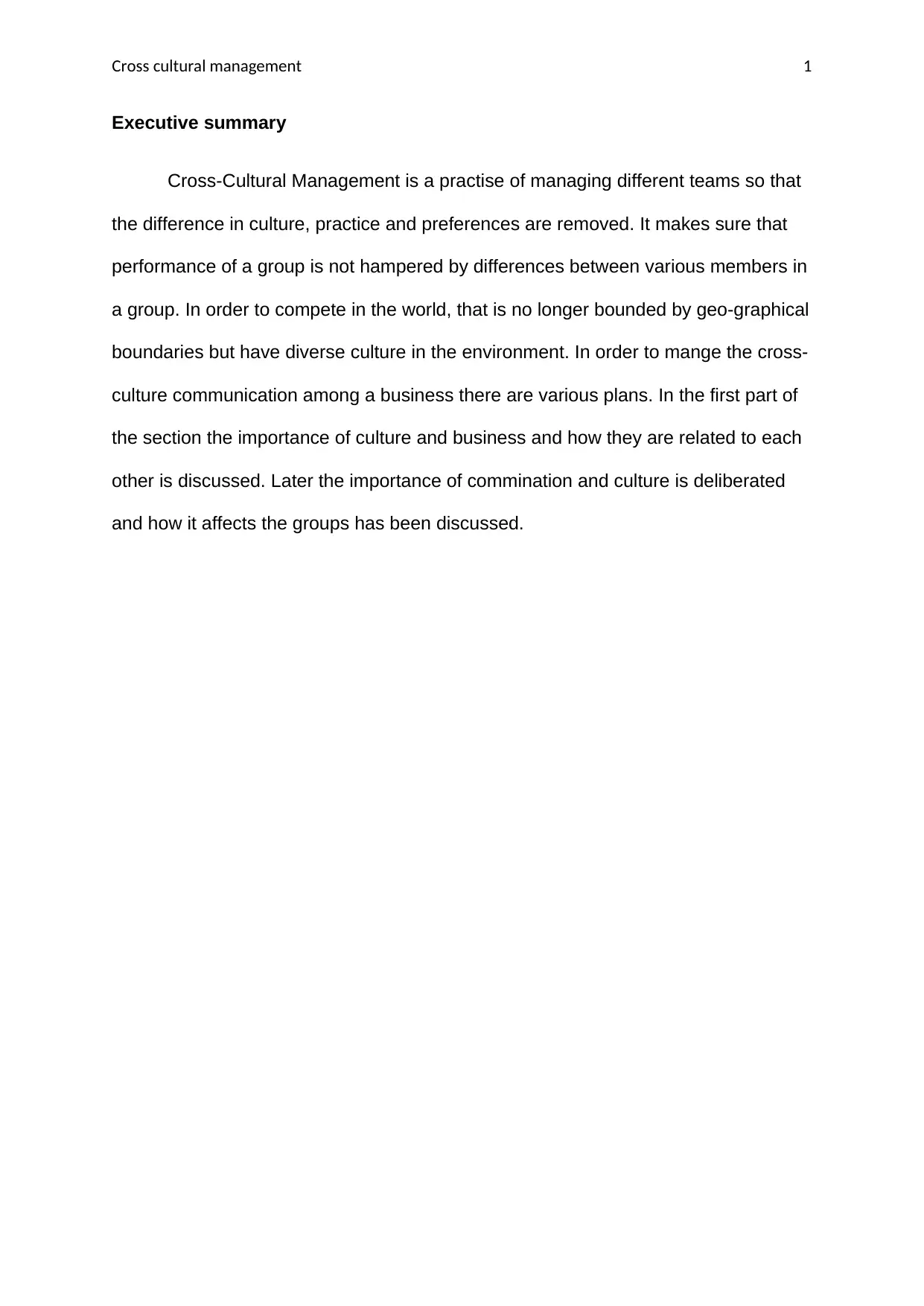
Cross cultural management 1
Executive summary
Cross-Cultural Management is a practise of managing different teams so that
the difference in culture, practice and preferences are removed. It makes sure that
performance of a group is not hampered by differences between various members in
a group. In order to compete in the world, that is no longer bounded by geo-graphical
boundaries but have diverse culture in the environment. In order to mange the cross-
culture communication among a business there are various plans. In the first part of
the section the importance of culture and business and how they are related to each
other is discussed. Later the importance of commination and culture is deliberated
and how it affects the groups has been discussed.
Executive summary
Cross-Cultural Management is a practise of managing different teams so that
the difference in culture, practice and preferences are removed. It makes sure that
performance of a group is not hampered by differences between various members in
a group. In order to compete in the world, that is no longer bounded by geo-graphical
boundaries but have diverse culture in the environment. In order to mange the cross-
culture communication among a business there are various plans. In the first part of
the section the importance of culture and business and how they are related to each
other is discussed. Later the importance of commination and culture is deliberated
and how it affects the groups has been discussed.
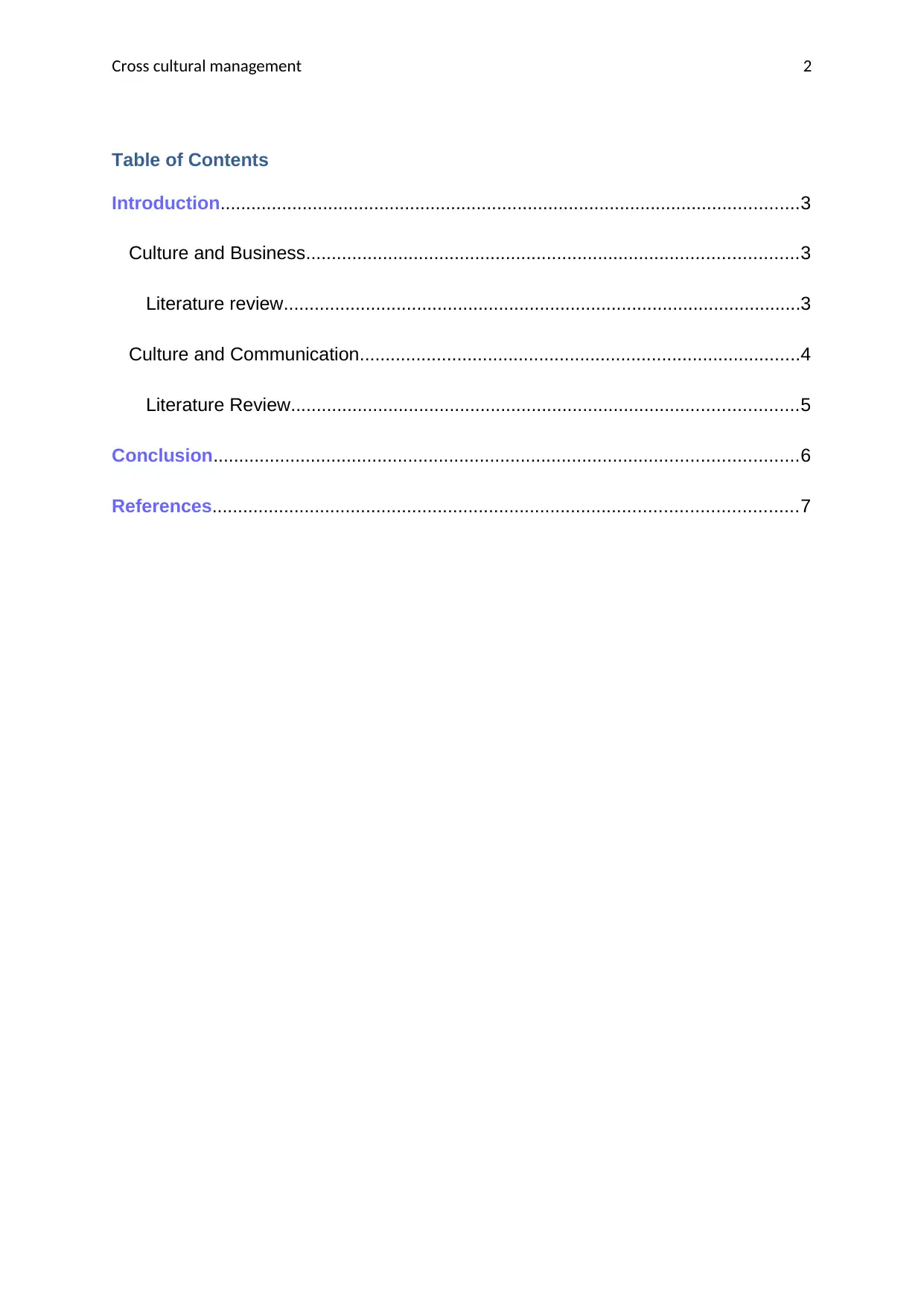
Cross cultural management 2
Table of Contents
Introduction.................................................................................................................3
Culture and Business................................................................................................3
Literature review.....................................................................................................3
Culture and Communication......................................................................................4
Literature Review...................................................................................................5
Conclusion..................................................................................................................6
References..................................................................................................................7
Table of Contents
Introduction.................................................................................................................3
Culture and Business................................................................................................3
Literature review.....................................................................................................3
Culture and Communication......................................................................................4
Literature Review...................................................................................................5
Conclusion..................................................................................................................6
References..................................................................................................................7
⊘ This is a preview!⊘
Do you want full access?
Subscribe today to unlock all pages.

Trusted by 1+ million students worldwide
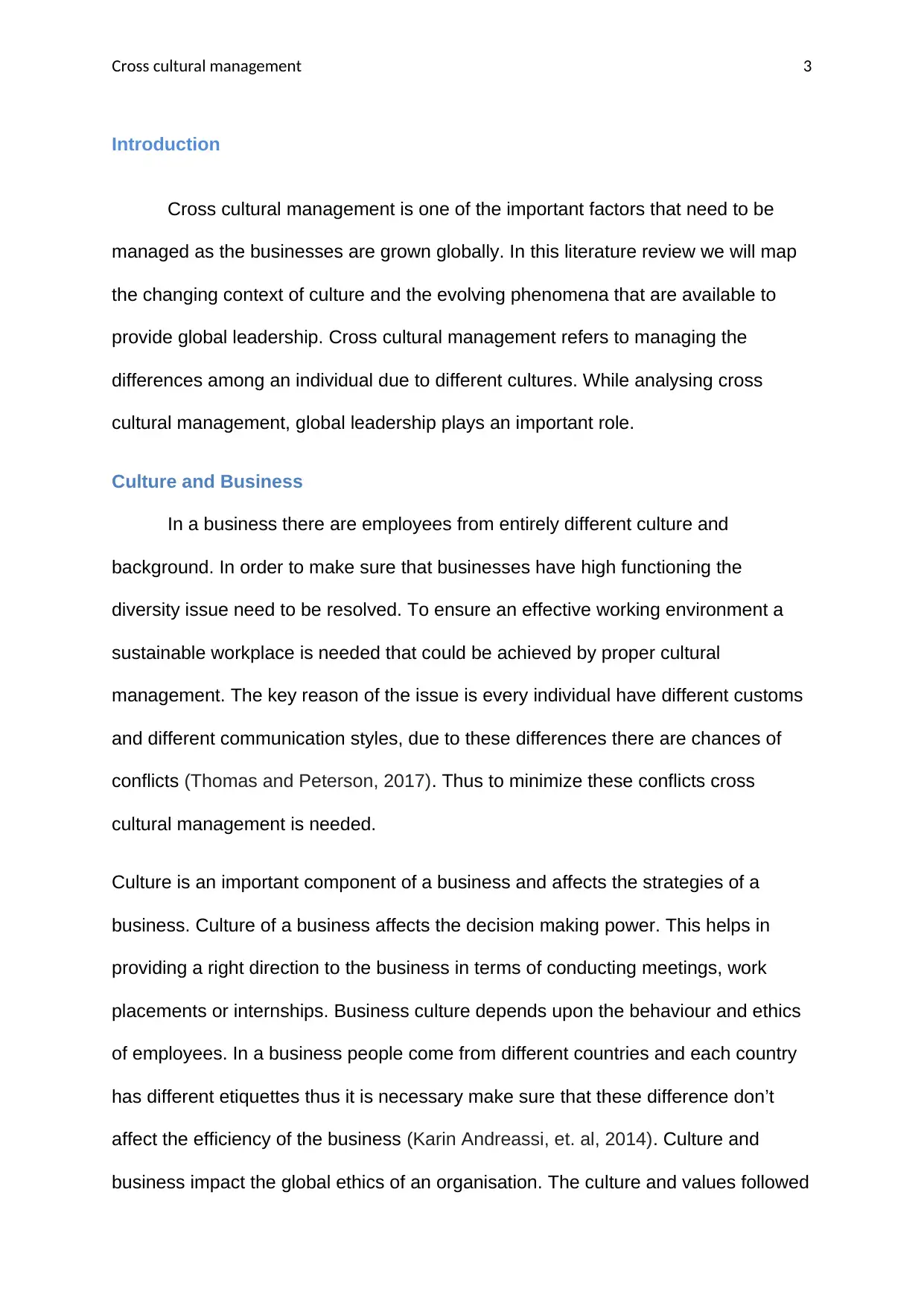
Cross cultural management 3
Introduction
Cross cultural management is one of the important factors that need to be
managed as the businesses are grown globally. In this literature review we will map
the changing context of culture and the evolving phenomena that are available to
provide global leadership. Cross cultural management refers to managing the
differences among an individual due to different cultures. While analysing cross
cultural management, global leadership plays an important role.
Culture and Business
In a business there are employees from entirely different culture and
background. In order to make sure that businesses have high functioning the
diversity issue need to be resolved. To ensure an effective working environment a
sustainable workplace is needed that could be achieved by proper cultural
management. The key reason of the issue is every individual have different customs
and different communication styles, due to these differences there are chances of
conflicts (Thomas and Peterson, 2017). Thus to minimize these conflicts cross
cultural management is needed.
Culture is an important component of a business and affects the strategies of a
business. Culture of a business affects the decision making power. This helps in
providing a right direction to the business in terms of conducting meetings, work
placements or internships. Business culture depends upon the behaviour and ethics
of employees. In a business people come from different countries and each country
has different etiquettes thus it is necessary make sure that these difference don’t
affect the efficiency of the business (Karin Andreassi, et. al, 2014). Culture and
business impact the global ethics of an organisation. The culture and values followed
Introduction
Cross cultural management is one of the important factors that need to be
managed as the businesses are grown globally. In this literature review we will map
the changing context of culture and the evolving phenomena that are available to
provide global leadership. Cross cultural management refers to managing the
differences among an individual due to different cultures. While analysing cross
cultural management, global leadership plays an important role.
Culture and Business
In a business there are employees from entirely different culture and
background. In order to make sure that businesses have high functioning the
diversity issue need to be resolved. To ensure an effective working environment a
sustainable workplace is needed that could be achieved by proper cultural
management. The key reason of the issue is every individual have different customs
and different communication styles, due to these differences there are chances of
conflicts (Thomas and Peterson, 2017). Thus to minimize these conflicts cross
cultural management is needed.
Culture is an important component of a business and affects the strategies of a
business. Culture of a business affects the decision making power. This helps in
providing a right direction to the business in terms of conducting meetings, work
placements or internships. Business culture depends upon the behaviour and ethics
of employees. In a business people come from different countries and each country
has different etiquettes thus it is necessary make sure that these difference don’t
affect the efficiency of the business (Karin Andreassi, et. al, 2014). Culture and
business impact the global ethics of an organisation. The culture and values followed
Paraphrase This Document
Need a fresh take? Get an instant paraphrase of this document with our AI Paraphraser
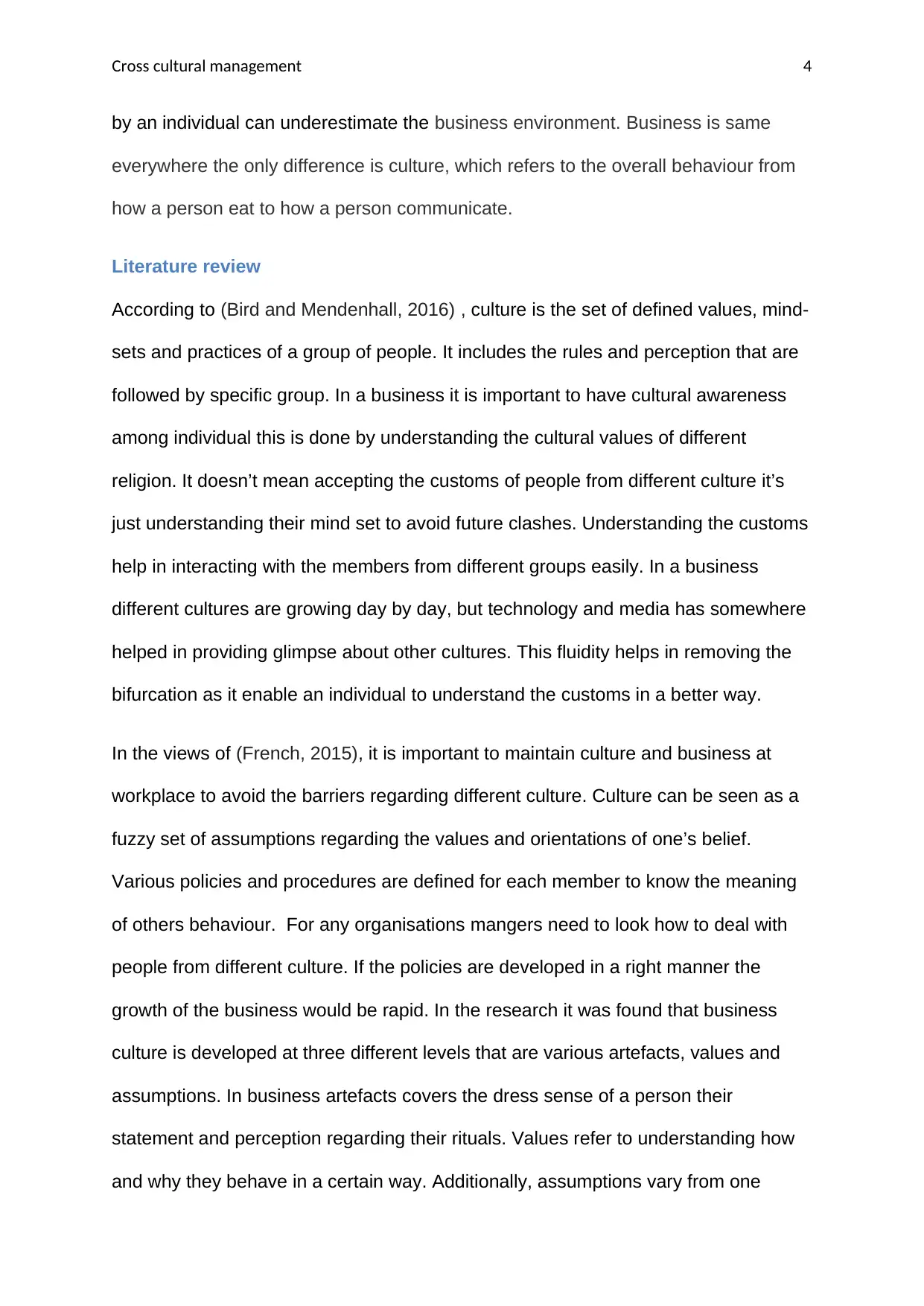
Cross cultural management 4
by an individual can underestimate the business environment. Business is same
everywhere the only difference is culture, which refers to the overall behaviour from
how a person eat to how a person communicate.
Literature review
According to (Bird and Mendenhall, 2016) , culture is the set of defined values, mind-
sets and practices of a group of people. It includes the rules and perception that are
followed by specific group. In a business it is important to have cultural awareness
among individual this is done by understanding the cultural values of different
religion. It doesn’t mean accepting the customs of people from different culture it’s
just understanding their mind set to avoid future clashes. Understanding the customs
help in interacting with the members from different groups easily. In a business
different cultures are growing day by day, but technology and media has somewhere
helped in providing glimpse about other cultures. This fluidity helps in removing the
bifurcation as it enable an individual to understand the customs in a better way.
In the views of (French, 2015), it is important to maintain culture and business at
workplace to avoid the barriers regarding different culture. Culture can be seen as a
fuzzy set of assumptions regarding the values and orientations of one’s belief.
Various policies and procedures are defined for each member to know the meaning
of others behaviour. For any organisations mangers need to look how to deal with
people from different culture. If the policies are developed in a right manner the
growth of the business would be rapid. In the research it was found that business
culture is developed at three different levels that are various artefacts, values and
assumptions. In business artefacts covers the dress sense of a person their
statement and perception regarding their rituals. Values refer to understanding how
and why they behave in a certain way. Additionally, assumptions vary from one
by an individual can underestimate the business environment. Business is same
everywhere the only difference is culture, which refers to the overall behaviour from
how a person eat to how a person communicate.
Literature review
According to (Bird and Mendenhall, 2016) , culture is the set of defined values, mind-
sets and practices of a group of people. It includes the rules and perception that are
followed by specific group. In a business it is important to have cultural awareness
among individual this is done by understanding the cultural values of different
religion. It doesn’t mean accepting the customs of people from different culture it’s
just understanding their mind set to avoid future clashes. Understanding the customs
help in interacting with the members from different groups easily. In a business
different cultures are growing day by day, but technology and media has somewhere
helped in providing glimpse about other cultures. This fluidity helps in removing the
bifurcation as it enable an individual to understand the customs in a better way.
In the views of (French, 2015), it is important to maintain culture and business at
workplace to avoid the barriers regarding different culture. Culture can be seen as a
fuzzy set of assumptions regarding the values and orientations of one’s belief.
Various policies and procedures are defined for each member to know the meaning
of others behaviour. For any organisations mangers need to look how to deal with
people from different culture. If the policies are developed in a right manner the
growth of the business would be rapid. In the research it was found that business
culture is developed at three different levels that are various artefacts, values and
assumptions. In business artefacts covers the dress sense of a person their
statement and perception regarding their rituals. Values refer to understanding how
and why they behave in a certain way. Additionally, assumptions vary from one
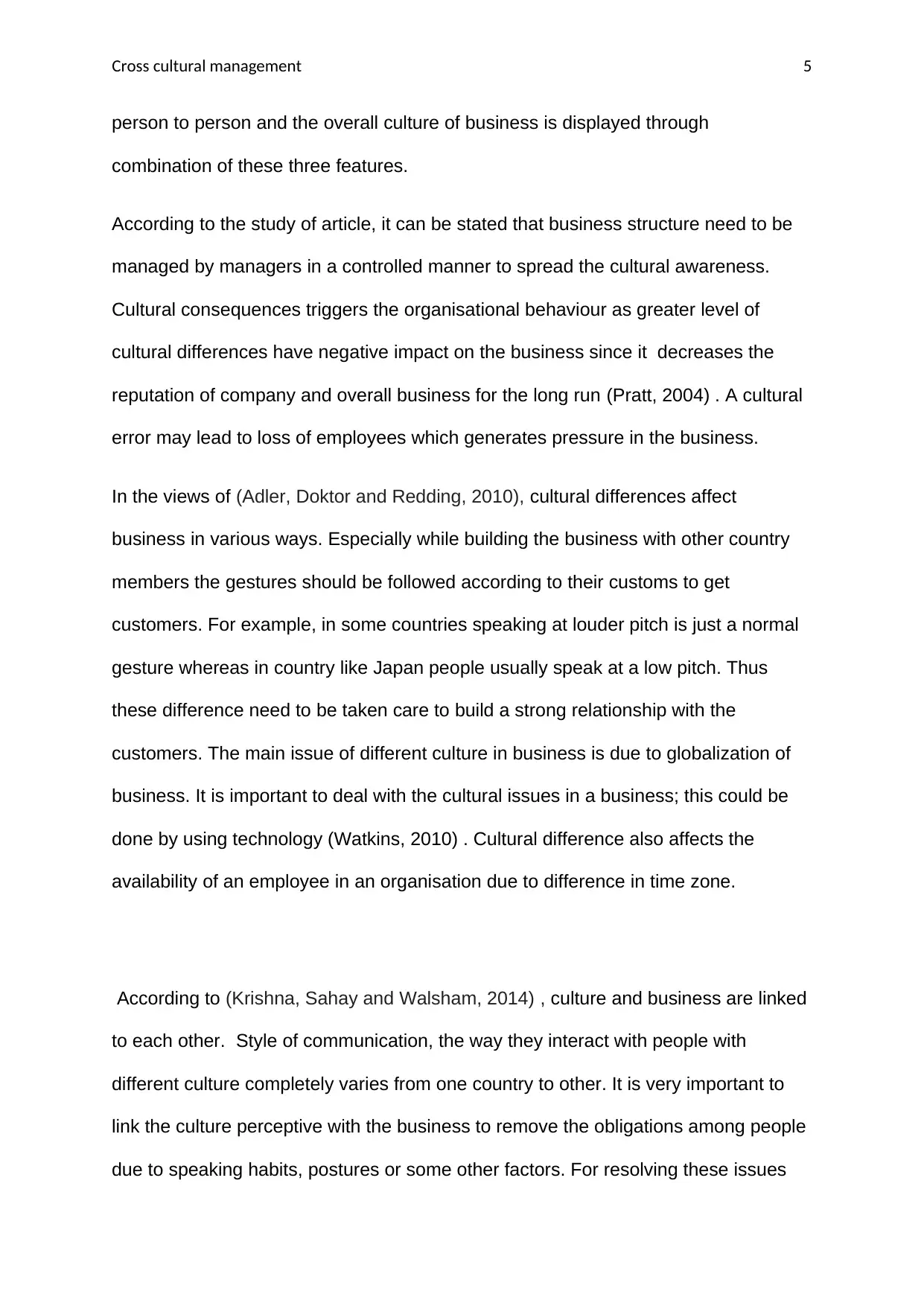
Cross cultural management 5
person to person and the overall culture of business is displayed through
combination of these three features.
According to the study of article, it can be stated that business structure need to be
managed by managers in a controlled manner to spread the cultural awareness.
Cultural consequences triggers the organisational behaviour as greater level of
cultural differences have negative impact on the business since it decreases the
reputation of company and overall business for the long run (Pratt, 2004) . A cultural
error may lead to loss of employees which generates pressure in the business.
In the views of (Adler, Doktor and Redding, 2010), cultural differences affect
business in various ways. Especially while building the business with other country
members the gestures should be followed according to their customs to get
customers. For example, in some countries speaking at louder pitch is just a normal
gesture whereas in country like Japan people usually speak at a low pitch. Thus
these difference need to be taken care to build a strong relationship with the
customers. The main issue of different culture in business is due to globalization of
business. It is important to deal with the cultural issues in a business; this could be
done by using technology (Watkins, 2010) . Cultural difference also affects the
availability of an employee in an organisation due to difference in time zone.
According to (Krishna, Sahay and Walsham, 2014) , culture and business are linked
to each other. Style of communication, the way they interact with people with
different culture completely varies from one country to other. It is very important to
link the culture perceptive with the business to remove the obligations among people
due to speaking habits, postures or some other factors. For resolving these issues
person to person and the overall culture of business is displayed through
combination of these three features.
According to the study of article, it can be stated that business structure need to be
managed by managers in a controlled manner to spread the cultural awareness.
Cultural consequences triggers the organisational behaviour as greater level of
cultural differences have negative impact on the business since it decreases the
reputation of company and overall business for the long run (Pratt, 2004) . A cultural
error may lead to loss of employees which generates pressure in the business.
In the views of (Adler, Doktor and Redding, 2010), cultural differences affect
business in various ways. Especially while building the business with other country
members the gestures should be followed according to their customs to get
customers. For example, in some countries speaking at louder pitch is just a normal
gesture whereas in country like Japan people usually speak at a low pitch. Thus
these difference need to be taken care to build a strong relationship with the
customers. The main issue of different culture in business is due to globalization of
business. It is important to deal with the cultural issues in a business; this could be
done by using technology (Watkins, 2010) . Cultural difference also affects the
availability of an employee in an organisation due to difference in time zone.
According to (Krishna, Sahay and Walsham, 2014) , culture and business are linked
to each other. Style of communication, the way they interact with people with
different culture completely varies from one country to other. It is very important to
link the culture perceptive with the business to remove the obligations among people
due to speaking habits, postures or some other factors. For resolving these issues
⊘ This is a preview!⊘
Do you want full access?
Subscribe today to unlock all pages.

Trusted by 1+ million students worldwide
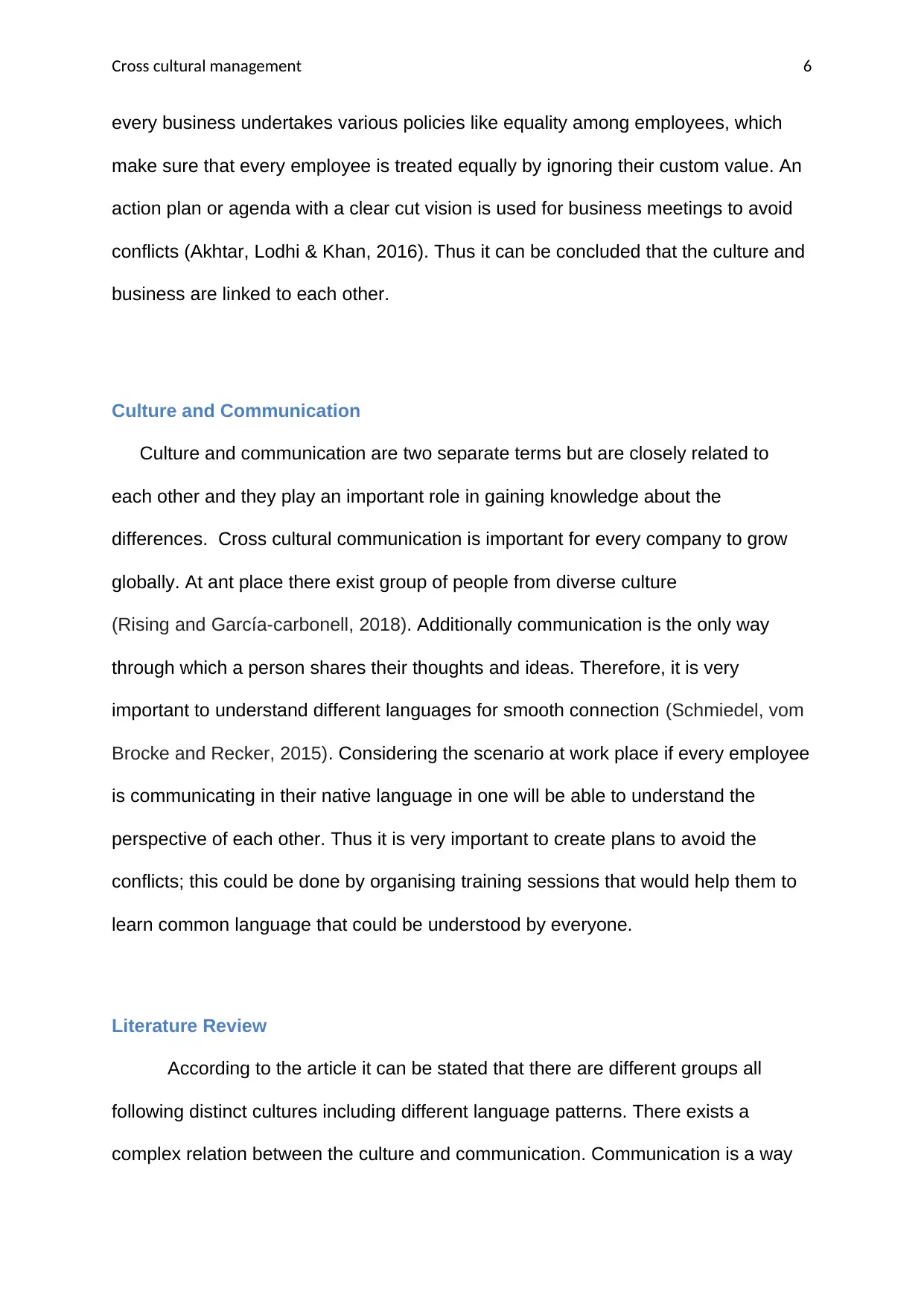
Cross cultural management 6
every business undertakes various policies like equality among employees, which
make sure that every employee is treated equally by ignoring their custom value. An
action plan or agenda with a clear cut vision is used for business meetings to avoid
conflicts (Akhtar, Lodhi & Khan, 2016). Thus it can be concluded that the culture and
business are linked to each other.
Culture and Communication
Culture and communication are two separate terms but are closely related to
each other and they play an important role in gaining knowledge about the
differences. Cross cultural communication is important for every company to grow
globally. At ant place there exist group of people from diverse culture
(Rising and García-carbonell, 2018). Additionally communication is the only way
through which a person shares their thoughts and ideas. Therefore, it is very
important to understand different languages for smooth connection (Schmiedel, vom
Brocke and Recker, 2015). Considering the scenario at work place if every employee
is communicating in their native language in one will be able to understand the
perspective of each other. Thus it is very important to create plans to avoid the
conflicts; this could be done by organising training sessions that would help them to
learn common language that could be understood by everyone.
Literature Review
According to the article it can be stated that there are different groups all
following distinct cultures including different language patterns. There exists a
complex relation between the culture and communication. Communication is a way
every business undertakes various policies like equality among employees, which
make sure that every employee is treated equally by ignoring their custom value. An
action plan or agenda with a clear cut vision is used for business meetings to avoid
conflicts (Akhtar, Lodhi & Khan, 2016). Thus it can be concluded that the culture and
business are linked to each other.
Culture and Communication
Culture and communication are two separate terms but are closely related to
each other and they play an important role in gaining knowledge about the
differences. Cross cultural communication is important for every company to grow
globally. At ant place there exist group of people from diverse culture
(Rising and García-carbonell, 2018). Additionally communication is the only way
through which a person shares their thoughts and ideas. Therefore, it is very
important to understand different languages for smooth connection (Schmiedel, vom
Brocke and Recker, 2015). Considering the scenario at work place if every employee
is communicating in their native language in one will be able to understand the
perspective of each other. Thus it is very important to create plans to avoid the
conflicts; this could be done by organising training sessions that would help them to
learn common language that could be understood by everyone.
Literature Review
According to the article it can be stated that there are different groups all
following distinct cultures including different language patterns. There exists a
complex relation between the culture and communication. Communication is a way
Paraphrase This Document
Need a fresh take? Get an instant paraphrase of this document with our AI Paraphraser
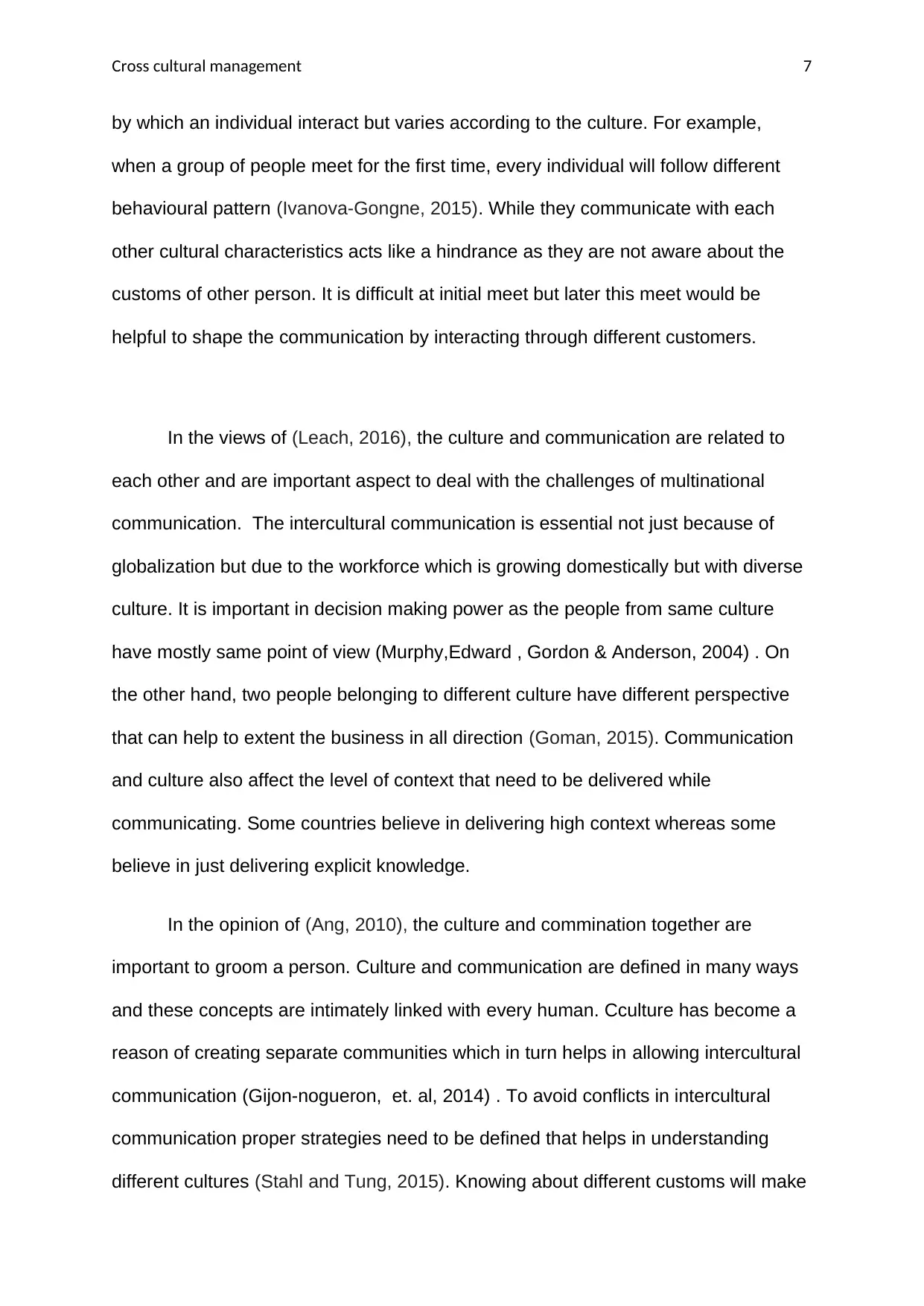
Cross cultural management 7
by which an individual interact but varies according to the culture. For example,
when a group of people meet for the first time, every individual will follow different
behavioural pattern (Ivanova-Gongne, 2015). While they communicate with each
other cultural characteristics acts like a hindrance as they are not aware about the
customs of other person. It is difficult at initial meet but later this meet would be
helpful to shape the communication by interacting through different customers.
In the views of (Leach, 2016), the culture and communication are related to
each other and are important aspect to deal with the challenges of multinational
communication. The intercultural communication is essential not just because of
globalization but due to the workforce which is growing domestically but with diverse
culture. It is important in decision making power as the people from same culture
have mostly same point of view (Murphy,Edward , Gordon & Anderson, 2004) . On
the other hand, two people belonging to different culture have different perspective
that can help to extent the business in all direction (Goman, 2015). Communication
and culture also affect the level of context that need to be delivered while
communicating. Some countries believe in delivering high context whereas some
believe in just delivering explicit knowledge.
In the opinion of (Ang, 2010), the culture and commination together are
important to groom a person. Culture and communication are defined in many ways
and these concepts are intimately linked with every human. Cculture has become a
reason of creating separate communities which in turn helps in allowing intercultural
communication (Gijon-nogueron, et. al, 2014) . To avoid conflicts in intercultural
communication proper strategies need to be defined that helps in understanding
different cultures (Stahl and Tung, 2015). Knowing about different customs will make
by which an individual interact but varies according to the culture. For example,
when a group of people meet for the first time, every individual will follow different
behavioural pattern (Ivanova-Gongne, 2015). While they communicate with each
other cultural characteristics acts like a hindrance as they are not aware about the
customs of other person. It is difficult at initial meet but later this meet would be
helpful to shape the communication by interacting through different customers.
In the views of (Leach, 2016), the culture and communication are related to
each other and are important aspect to deal with the challenges of multinational
communication. The intercultural communication is essential not just because of
globalization but due to the workforce which is growing domestically but with diverse
culture. It is important in decision making power as the people from same culture
have mostly same point of view (Murphy,Edward , Gordon & Anderson, 2004) . On
the other hand, two people belonging to different culture have different perspective
that can help to extent the business in all direction (Goman, 2015). Communication
and culture also affect the level of context that need to be delivered while
communicating. Some countries believe in delivering high context whereas some
believe in just delivering explicit knowledge.
In the opinion of (Ang, 2010), the culture and commination together are
important to groom a person. Culture and communication are defined in many ways
and these concepts are intimately linked with every human. Cculture has become a
reason of creating separate communities which in turn helps in allowing intercultural
communication (Gijon-nogueron, et. al, 2014) . To avoid conflicts in intercultural
communication proper strategies need to be defined that helps in understanding
different cultures (Stahl and Tung, 2015). Knowing about different customs will make

Cross cultural management 8
communication easy and it also enhances an individual to adapt to new cultures and
relations. Additionally it also builds a bridge between different cultures.
communication easy and it also enhances an individual to adapt to new cultures and
relations. Additionally it also builds a bridge between different cultures.
⊘ This is a preview!⊘
Do you want full access?
Subscribe today to unlock all pages.

Trusted by 1+ million students worldwide
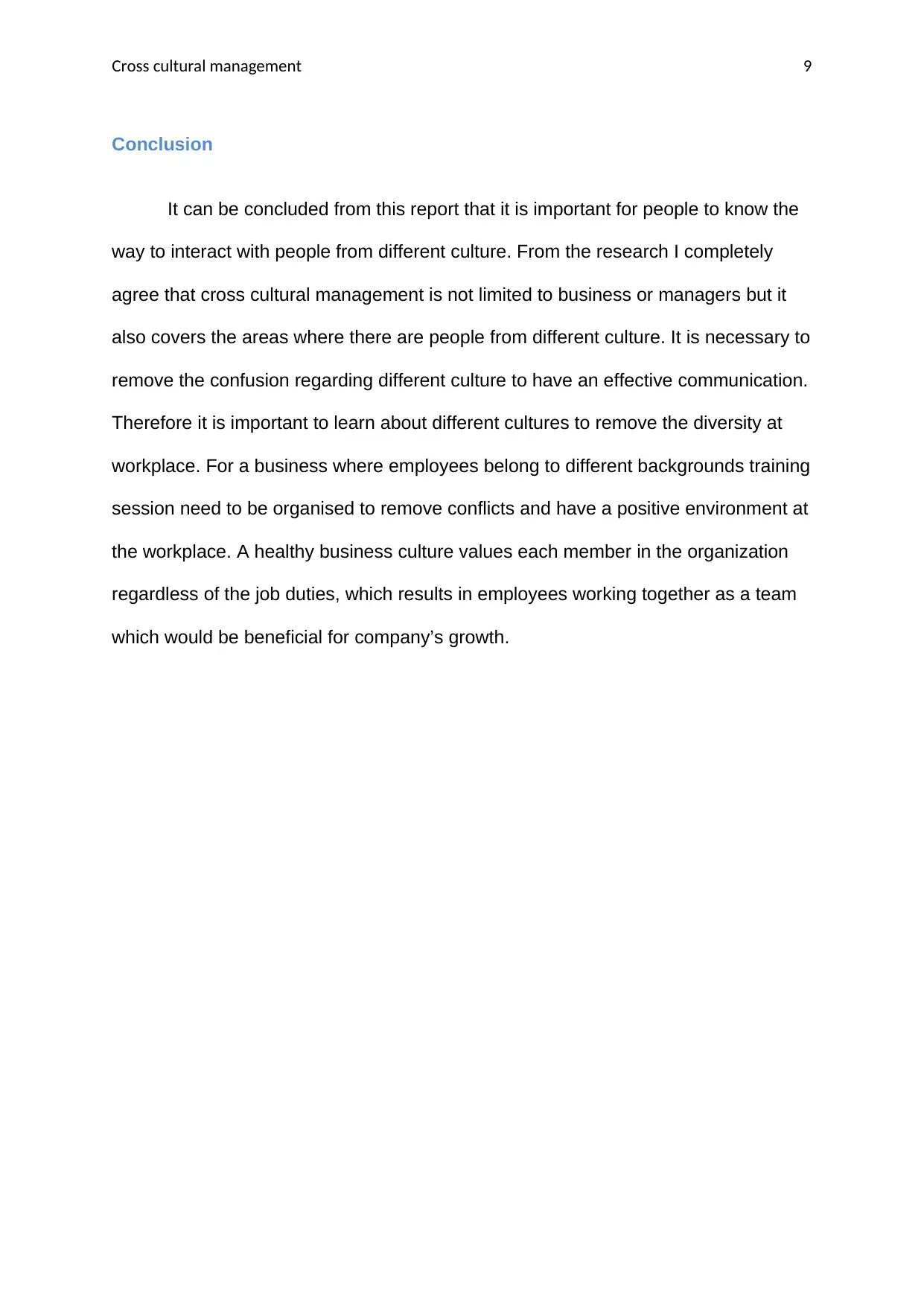
Cross cultural management 9
Conclusion
It can be concluded from this report that it is important for people to know the
way to interact with people from different culture. From the research I completely
agree that cross cultural management is not limited to business or managers but it
also covers the areas where there are people from different culture. It is necessary to
remove the confusion regarding different culture to have an effective communication.
Therefore it is important to learn about different cultures to remove the diversity at
workplace. For a business where employees belong to different backgrounds training
session need to be organised to remove conflicts and have a positive environment at
the workplace. A healthy business culture values each member in the organization
regardless of the job duties, which results in employees working together as a team
which would be beneficial for company’s growth.
Conclusion
It can be concluded from this report that it is important for people to know the
way to interact with people from different culture. From the research I completely
agree that cross cultural management is not limited to business or managers but it
also covers the areas where there are people from different culture. It is necessary to
remove the confusion regarding different culture to have an effective communication.
Therefore it is important to learn about different cultures to remove the diversity at
workplace. For a business where employees belong to different backgrounds training
session need to be organised to remove conflicts and have a positive environment at
the workplace. A healthy business culture values each member in the organization
regardless of the job duties, which results in employees working together as a team
which would be beneficial for company’s growth.
Paraphrase This Document
Need a fresh take? Get an instant paraphrase of this document with our AI Paraphraser
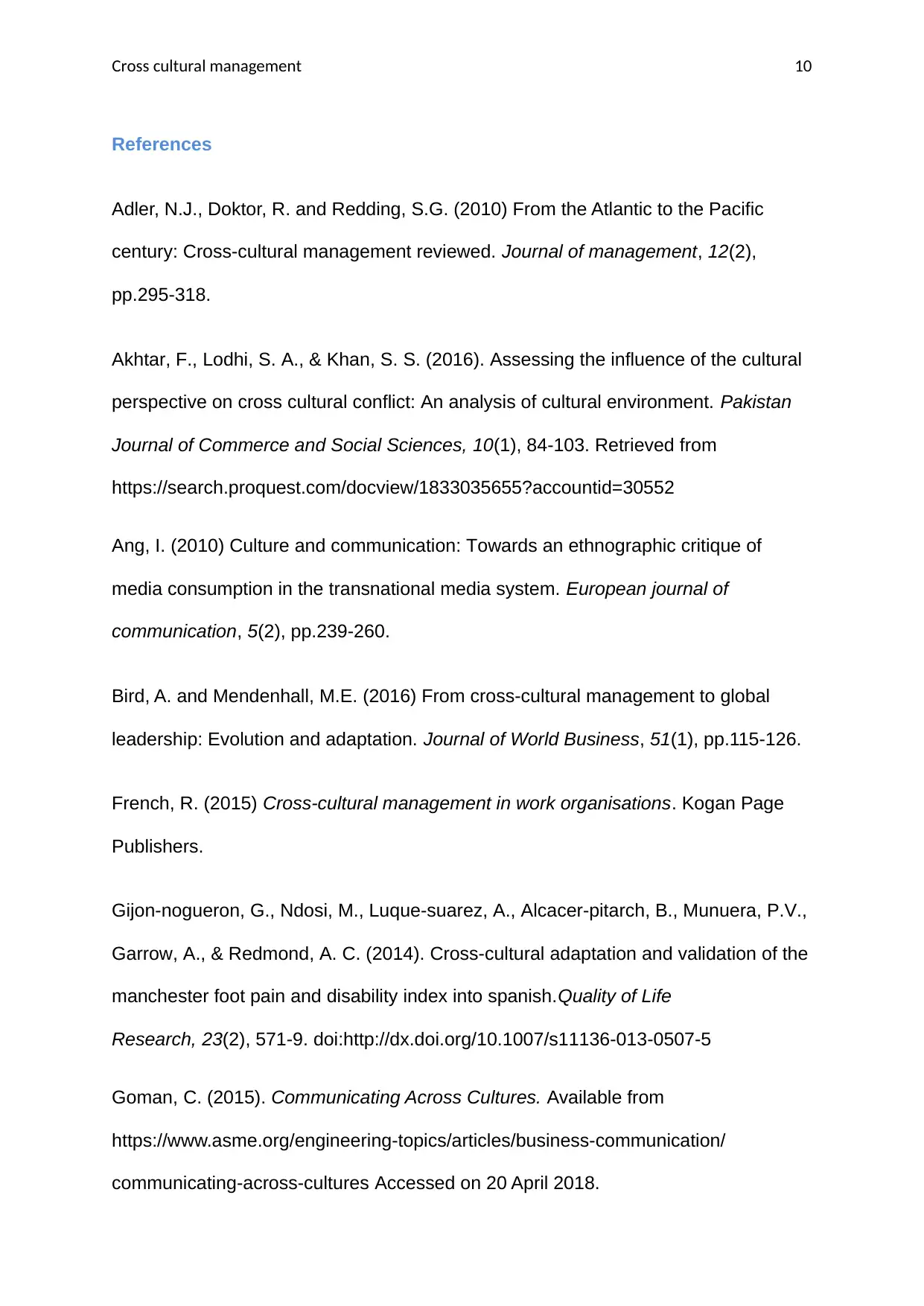
Cross cultural management 10
References
Adler, N.J., Doktor, R. and Redding, S.G. (2010) From the Atlantic to the Pacific
century: Cross-cultural management reviewed. Journal of management, 12(2),
pp.295-318.
Akhtar, F., Lodhi, S. A., & Khan, S. S. (2016). Assessing the influence of the cultural
perspective on cross cultural conflict: An analysis of cultural environment. Pakistan
Journal of Commerce and Social Sciences, 10(1), 84-103. Retrieved from
https://search.proquest.com/docview/1833035655?accountid=30552
Ang, I. (2010) Culture and communication: Towards an ethnographic critique of
media consumption in the transnational media system. European journal of
communication, 5(2), pp.239-260.
Bird, A. and Mendenhall, M.E. (2016) From cross-cultural management to global
leadership: Evolution and adaptation. Journal of World Business, 51(1), pp.115-126.
French, R. (2015) Cross-cultural management in work organisations. Kogan Page
Publishers.
Gijon-nogueron, G., Ndosi, M., Luque-suarez, A., Alcacer-pitarch, B., Munuera, P.V.,
Garrow, A., & Redmond, A. C. (2014). Cross-cultural adaptation and validation of the
manchester foot pain and disability index into spanish.Quality of Life
Research, 23(2), 571-9. doi:http://dx.doi.org/10.1007/s11136-013-0507-5
Goman, C. (2015). Communicating Across Cultures. Available from
https://www.asme.org/engineering-topics/articles/business-communication/
communicating-across-cultures Accessed on 20 April 2018.
References
Adler, N.J., Doktor, R. and Redding, S.G. (2010) From the Atlantic to the Pacific
century: Cross-cultural management reviewed. Journal of management, 12(2),
pp.295-318.
Akhtar, F., Lodhi, S. A., & Khan, S. S. (2016). Assessing the influence of the cultural
perspective on cross cultural conflict: An analysis of cultural environment. Pakistan
Journal of Commerce and Social Sciences, 10(1), 84-103. Retrieved from
https://search.proquest.com/docview/1833035655?accountid=30552
Ang, I. (2010) Culture and communication: Towards an ethnographic critique of
media consumption in the transnational media system. European journal of
communication, 5(2), pp.239-260.
Bird, A. and Mendenhall, M.E. (2016) From cross-cultural management to global
leadership: Evolution and adaptation. Journal of World Business, 51(1), pp.115-126.
French, R. (2015) Cross-cultural management in work organisations. Kogan Page
Publishers.
Gijon-nogueron, G., Ndosi, M., Luque-suarez, A., Alcacer-pitarch, B., Munuera, P.V.,
Garrow, A., & Redmond, A. C. (2014). Cross-cultural adaptation and validation of the
manchester foot pain and disability index into spanish.Quality of Life
Research, 23(2), 571-9. doi:http://dx.doi.org/10.1007/s11136-013-0507-5
Goman, C. (2015). Communicating Across Cultures. Available from
https://www.asme.org/engineering-topics/articles/business-communication/
communicating-across-cultures Accessed on 20 April 2018.
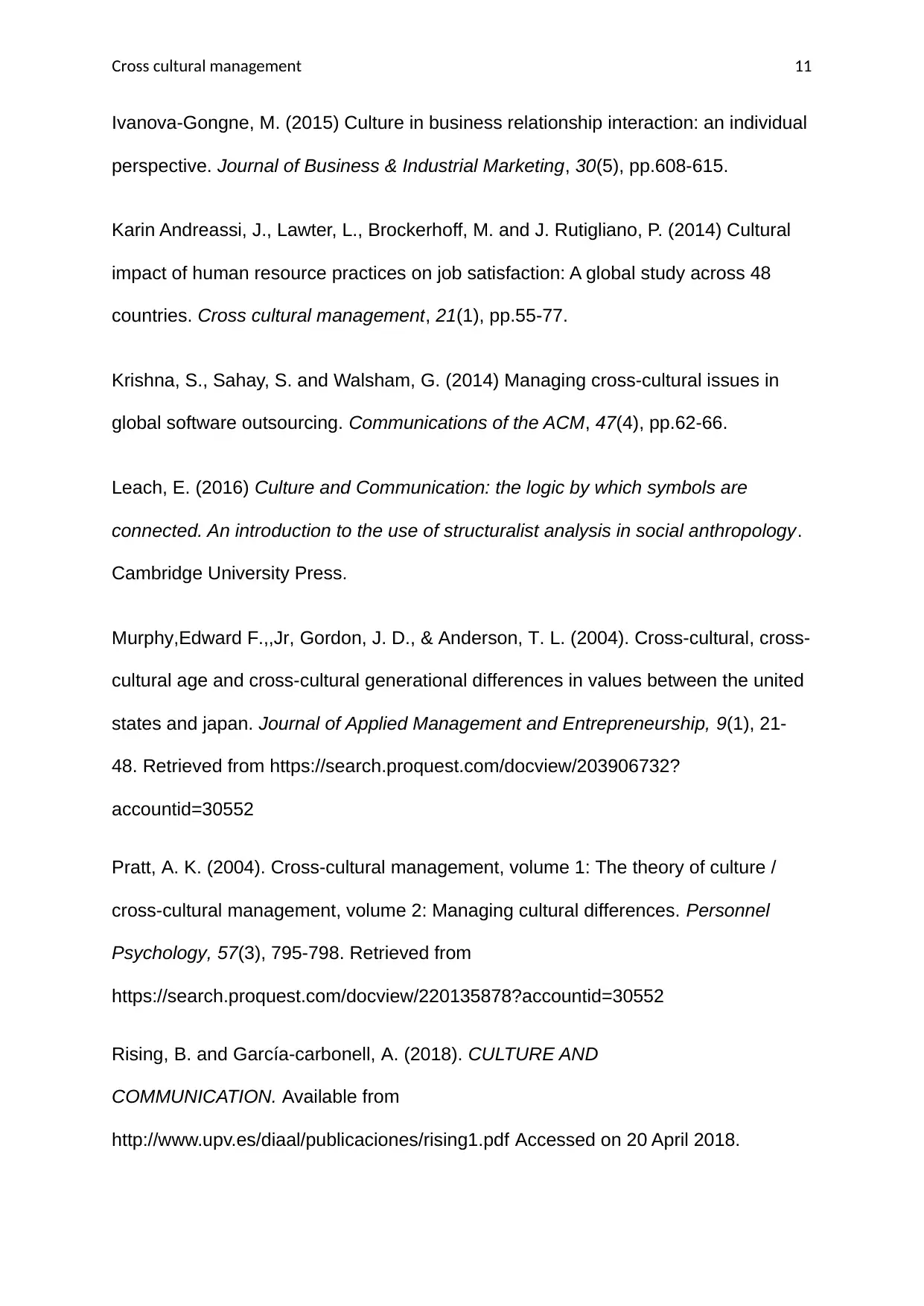
Cross cultural management 11
Ivanova-Gongne, M. (2015) Culture in business relationship interaction: an individual
perspective. Journal of Business & Industrial Marketing, 30(5), pp.608-615.
Karin Andreassi, J., Lawter, L., Brockerhoff, M. and J. Rutigliano, P. (2014) Cultural
impact of human resource practices on job satisfaction: A global study across 48
countries. Cross cultural management, 21(1), pp.55-77.
Krishna, S., Sahay, S. and Walsham, G. (2014) Managing cross-cultural issues in
global software outsourcing. Communications of the ACM, 47(4), pp.62-66.
Leach, E. (2016) Culture and Communication: the logic by which symbols are
connected. An introduction to the use of structuralist analysis in social anthropology.
Cambridge University Press.
Murphy,Edward F.,,Jr, Gordon, J. D., & Anderson, T. L. (2004). Cross-cultural, cross-
cultural age and cross-cultural generational differences in values between the united
states and japan. Journal of Applied Management and Entrepreneurship, 9(1), 21-
48. Retrieved from https://search.proquest.com/docview/203906732?
accountid=30552
Pratt, A. K. (2004). Cross-cultural management, volume 1: The theory of culture /
cross-cultural management, volume 2: Managing cultural differences. Personnel
Psychology, 57(3), 795-798. Retrieved from
https://search.proquest.com/docview/220135878?accountid=30552
Rising, B. and García-carbonell, A. (2018). CULTURE AND
COMMUNICATION. Available from
http://www.upv.es/diaal/publicaciones/rising1.pdf Accessed on 20 April 2018.
Ivanova-Gongne, M. (2015) Culture in business relationship interaction: an individual
perspective. Journal of Business & Industrial Marketing, 30(5), pp.608-615.
Karin Andreassi, J., Lawter, L., Brockerhoff, M. and J. Rutigliano, P. (2014) Cultural
impact of human resource practices on job satisfaction: A global study across 48
countries. Cross cultural management, 21(1), pp.55-77.
Krishna, S., Sahay, S. and Walsham, G. (2014) Managing cross-cultural issues in
global software outsourcing. Communications of the ACM, 47(4), pp.62-66.
Leach, E. (2016) Culture and Communication: the logic by which symbols are
connected. An introduction to the use of structuralist analysis in social anthropology.
Cambridge University Press.
Murphy,Edward F.,,Jr, Gordon, J. D., & Anderson, T. L. (2004). Cross-cultural, cross-
cultural age and cross-cultural generational differences in values between the united
states and japan. Journal of Applied Management and Entrepreneurship, 9(1), 21-
48. Retrieved from https://search.proquest.com/docview/203906732?
accountid=30552
Pratt, A. K. (2004). Cross-cultural management, volume 1: The theory of culture /
cross-cultural management, volume 2: Managing cultural differences. Personnel
Psychology, 57(3), 795-798. Retrieved from
https://search.proquest.com/docview/220135878?accountid=30552
Rising, B. and García-carbonell, A. (2018). CULTURE AND
COMMUNICATION. Available from
http://www.upv.es/diaal/publicaciones/rising1.pdf Accessed on 20 April 2018.
⊘ This is a preview!⊘
Do you want full access?
Subscribe today to unlock all pages.

Trusted by 1+ million students worldwide
1 out of 13
Related Documents
Your All-in-One AI-Powered Toolkit for Academic Success.
+13062052269
info@desklib.com
Available 24*7 on WhatsApp / Email
![[object Object]](/_next/static/media/star-bottom.7253800d.svg)
Unlock your academic potential
Copyright © 2020–2025 A2Z Services. All Rights Reserved. Developed and managed by ZUCOL.



